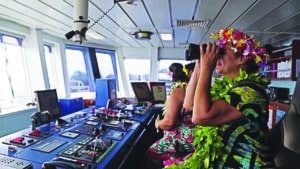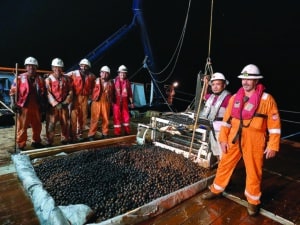As net-zero targets loom, deep-sea mining may soon have its day in the sun. But what is it? And how will it change the future of mining?
If global targets for emissions reduction are to be achieved, then the critical minerals necessary for the transition to clean energy need to be sourced – and quickly.
While mining operations for battery metals are underway across the world, concern is rising over whether the resources contained in conventional surface and underground mines will be enough to meet the demands of the net-zero shift.
But the answer to the supply issue may lay deep below the surface of the ocean where critical resources are lying in wait.
The deep sea holds a trove of critical minerals including copper, cobalt, nickel, manganese, zinc, silver, gold and even rare earth elements.
Critical minerals can be extracted from two types of seafloor deposits. The first of these is seafloor massive sulphides (SMS).
SMS deposits form when cold seawater percolates down through the seafloor where it is heated and, as it rises, metals and sulphides are dissolved from the surrounding rocks.
As the rising hydrothermal fluid interacts with the cold sea water there is rapid precipitation of metal sulphides leading to chimney formations, with subsequent chimney collapse and coalescence forming sulphide mounds.
SMS deposits can contain copper, zinc, silver and gold, but are usually only mined once the chimneys are no longer active due to hot gasses and marine life.
Usually, the extinct SMS structures need to be cut before the ore is extracted from the sea floor. The ore is lifted or pumped in a slurry from the sea floor up to a ship so it can be delivered to onshore processing facilities to be refined.
The second source of critical minerals in the ocean come from mineral-rich nodules that have formed on the sea floor by the billions.
The deposits are called polymetallic nodules, formed by metals in the seawater precipitating around a small biological particle, often a fragment of fish bone laying on the seafloor.
These nodules are mostly made up of metals like manganese, iron, cobalt, nickel, copper and rare earth metals.

Last year Moana Minerals, a subsidiary of sea floor explorer Ocean Minerals (OM), was one of three companies granted a polymetallic nodules exploration licence in the Cook Islands exclusive economic zone (EEZ).
Ocean Minerals aims to provide the world with the critical minerals needed for renewable energy through the responsible extraction of polymetallic nodules from the ocean.
Chief executive officer Hans Smit told Australian Mining the company intends to use what is essentially a 16m wide vacuum nozzle to suck the nodules from the sea floor.
“We create a suction force by using water injected into the into the nozzle which causes a vacuum and then we use that vacuum to lift the nodules off the seafloor as a slurry,” he said.
“Inside the seafloor machine the nodules are separated from the slurry with the bulk of sediment exiting out the back of the machine. The nodules are then get transported vertically to the production vessel.”
After separation from water and sediment on the production vessel, the nodules are collected for shipment to onshore processing plants.
Once the mineral products are removed from the nodules there should be little waste left over, making the process an environmentally conscious practice.
The average Cook Islands nodules are the size of golf balls with nodules in the 4.5 million square kilometre Clarion-Clipperton zone (CCZ) between Hawaii and Mexico being as large as a grapefruit.
The Cook Islands Government has actively encouraged environmentally responsible exploration and will use the data gathered to make an informed decision about potentially harvesting the nodules.
“This exploration phase we are entering into is exciting and will open up a whole new world for us,” Cook Islands Prime Minister Mark Brown said of the issuing of the first licences to OM and two other companies.
But leaders from the Melanesia Spearhead Group comprising of Papua New Guinea (PNG), Fiji, the Solomon Islands, Vanuatu and an alliance of pro-independence political parties from the French territory of New Caledonia, recently issued a moratorium on deep-sea mining in their jurisdictions until more is understood about the environmental impacts.
This follows the shelving of PNG’s Solwara 1 project, which would have seen the undertaking of deep-sea exploration and mining of SMS deposits of copper, gold, zinc and silver from the Bismarck Sea.
But PNG Prime Minister James Marape declared the Solwara 1 project will not go ahead without due diligence carried out regarding the potential environmental impacts.
Ocean Minerals is no stranger to due diligence. The licencing process in the Cook Islands took well over a year to even be considered as a candidate, with extreme measures taken to ensure the sustainability of the project and the minimised risk to the environment.
“It took a lot of a lot of hard work, planning and risk assessments to ensure we would qualify,” Smit said.
“Before we can even consider submitting for a mining licence, we need an environmental permit. All the work at the moment is focused on making sure we meet all those criteria.”
With no environmental baseline to refer to for the largely unexplored area of sea floor, OM will spend the next two years and US$25 million ($38.9 million) establishing that baseline before an environmental impact statement can even begin.
After that, rigorous stakeholder and public engagement and assessment will unfold before a decision to mine is reached.
But Smit believes the Ocean Minerals exploration and extraction project could sway the neighbouring island nations to follow the Cook Islands’ lead in allowing the extraction of polymetallic nodules should it meet the terms of the nation’s expectations for environmental responsibility.
Smit said the impact of deep-sea mining on the environment is misunderstood, as polymetallic nodules carpet the sea floor in barren stretches largely devoid of life.
Even SMS mining, which has been the centre of debate in the media for concerns of marine life dependant on the deposits, is largely misrepresented.
The SMS mining only targets dead deposits that no longer house life, as the hot gasses that marine life thrive on create a hostile environment inhibiting extraction.

Another concern is that sediment plumes created in SMS mining and polymetallic nodule extraction could affect marine life, but early evidence in the Cook Islands show these plumes dissipate quickly and are not the potential threat to life they were feared to be.
Should deep-sea mining exploration go ahead amongst the island nations the potential for the contribution to the net-zero push could be huge, with findings from initial research on the Solwara 1 SMS project positioning PNG as a potential major player in the budding field.
As for concerns over the removal of polymetallic nodules on marine ecosystems, Smit said the nodule free landscapes created by the removal of the nodules will transform into hubs of life, reflecting similar habitats adjacent the nodule fields.
“We spend a lot of our time trying to inform people about the research we’re doing and the data we’re collecting,” he said.
“Because a moratorium doesn’t mean ‘no’, a moratorium says ‘we need more data’. Let’s all work together to get that data.”
Smit emphasised the reason that data is so important is that the polymetallic nodules are the only resource on the earth that can sufficiently provide the extra metals needed to achieve the transition to alternative energies.
A renewable future is going to take millions of tonnes of minerals to realise. Only through exploring all avenues to getting those minerals will the transition be successful.
And it must be successful if we are to reach net-zero. Whether that means sourcing critical minerals from land or from the ocean, the answers we need are lurking deep below the surface.



